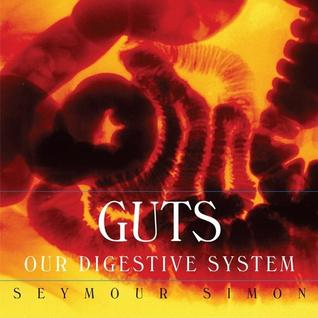

What do you notice regarding the similarities in the types of details included in these sentences from two different books by Seymour Simon?
Your backbone, or spine, is a flexible column of bones that runs down the middle of your body. It is made up of a chain of thirty-three small bones called vertebrae, which are fastened one on top of another. Each vertebra is hard and hollow, like a bead or a spool of thread. The joint between each vertebra allows only a small amount of movement, but together the vertebrae form a flexible chain of bones that can twist like a strong of beads. Your spine lets you bend down and touch your toes, and at the same time it keeps your body upright. (n. pag)
From Bones: Our Skeletal System (Simon, 2002)
Point to your stomach. Surprise! It’s not behind your belly button, but higher up, tucked just beneath the left side of your rib cage. An empty stomach is shaped like the letter J, and it’s only about as big as your fist. Deep, soft folds called rugae line the inside of the stomach. After you eat a meal, the folds flatten out and your stomach swells up. It can get as big as a boxing glove.
From Guts: Our Digestive System (Simon, 2005)
This is what I notice –
- In the first few sentences, Simon names the part of the body and the location of that part within the body. “Backbone, or spine” – “runs down the middle of your body” AND “stomach” – “not behind your belly button, but higher up, tucked just beneath the left side of your rib cage.”
- Simon uses comparisons to real life objects to help the reader understand the physical attributes of these parts of the body – “like a bead or a spool of thread” (density) AND “like the letter J” (shape) and “only about as big as your fist” (size) and “as big as a boxing glove” (size)
- Simon describes sub-parts of the body part – “vertebra” and “rugae”; if you read further in Guts (Simon, 2005) (the next paragraph after this excerpt), Simon describes additional sub-parts – “three sets of powerful muscles.”
- AND more.
How might comparing two excerpts from books or articles by the same author be used as a way to help students think critically? (And also align with the Common Core?)
1) Gradual release during a close reading lesson – modeling with one excerpt and then providing a second and third excerpt for partner and independent analysis. A lesson using this framework might be focused on one of the following –
-
- identifying the author’s main idea and explaining how it is supported by key details (R.I. 4.3)
- explaining the structure of a text excerpt (R.I. 4.5)
- analyzing how a particular sentence, paragraph…fits into the overall structure of a text and contributes to the development of the ideas (R.I. 6.5)
- determining the meaning of words and phrases as they are used in a text, including figurative… (R.I.7.4)
This would be a way – working with excerpts from multiple texts by the same author – to deepen students’ understanding and thinking in so many ways. So many times, we barely touch the surface of learning during lessons and then move on. By using multiple excerpts from texts by the same author -students may begin to see patterns in structure, in how main ideas are developed, in how particular types of details are employed.
2) As mentor texts for students writing information/expository pieces – in particular, students who are focused on developing the topic with “facts, definitions, concrete details…” (W.5.2.b) or for writing arguments. Frequently we teach a structure of writing without providing numerous mentor texts – I think looking at how one author writes several pieces in a particular author might be an eye opening experience for student writers.
Other authors whose writing in multiple texts might be used…
- 3-5th GRADE – Nic Bishop – consider how he describes animals in two books like Frogs and Snakes
- MIDDLE SCHOOL – Stephen Ornes – look at the multiple articles he’s written for Science News for Kids –http://www.sciencenewsforkids.com.php5-17.dfw1-2.websitetestlink.com/wp/author/stephen_ornes/page/2/
. How does he use experts to support his points? How does he introduce the topic? What other types of details does he use consistently?
- 3rd-8th GRADE – Some published-for-school magazines use the same authors in multiple issues. Check out articles written by Beth Geiger –
Geiger, B. (2010). Active earth. National Geographic Explorer! Pathfinder Edition, 10(1), 8-13.
Geiger, B. (2013). Extreme ice. National Geographic Explorer! Pioneer Edition, 12(4), 15-23.
- MIDDLE – HIGH SCHOOL – Another option is choosing multiple essays written by the same columnist for a newspaper like Thomas Friedman for the New York Times.
Hope this helps.
Here are links to previous blog entries with Tip #1 and Tip #2 for locating and using paired informational texts. 🙂
